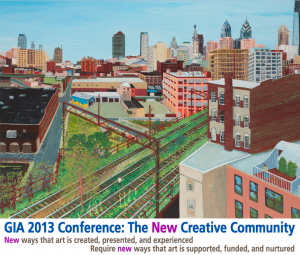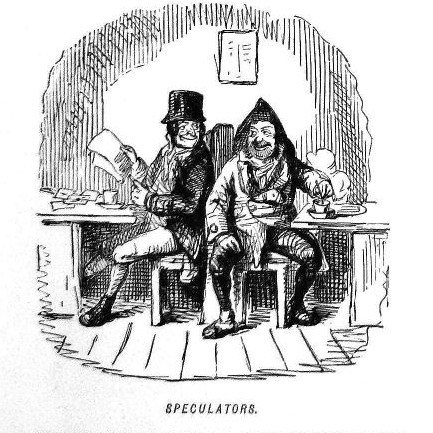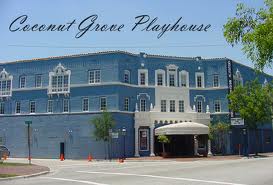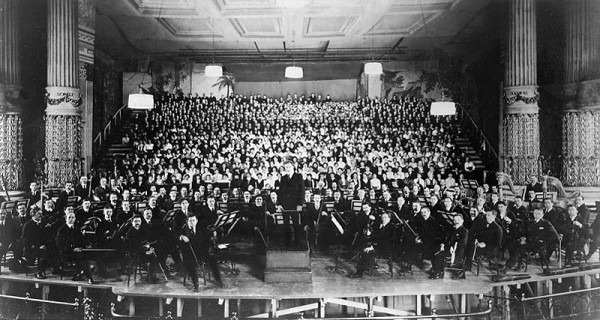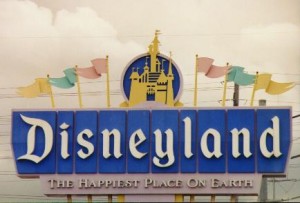 Last week I gave a brief talk in Edinburgh (at an event sponsored by Mission, Models, Money) for a small gathering of leaders in the arts and culture sector. The aim was of the meeting was to examine and reframe thinking about building-based arts and cultural organizations. I happened to read a book on reframing over the holidays—Reframing: The Art of Thinking Differently, by Karim Benammar. Reframing is a technique that Benammar uses to help individuals and organizations ask themselves two questions: Why do we do the things we do? How can we do things differently?
Last week I gave a brief talk in Edinburgh (at an event sponsored by Mission, Models, Money) for a small gathering of leaders in the arts and culture sector. The aim was of the meeting was to examine and reframe thinking about building-based arts and cultural organizations. I happened to read a book on reframing over the holidays—Reframing: The Art of Thinking Differently, by Karim Benammar. Reframing is a technique that Benammar uses to help individuals and organizations ask themselves two questions: Why do we do the things we do? How can we do things differently?
There are four steps to the process:
- Determine a core belief
- Find supporting beliefs
- Construct opposites for your supporting beliefs
- Find a new core belief
Reframing is a process for, in a sense, challenging your current perspectives. For instance, I could start with a core belief like “Lack of a physical building is a liability for a performing arts organization†or “Cultural districts improve the cities in which they are located†or “Arts organizations require contributions to operate.†In general, it’s good to start with a belief that you are unhappy with as the goal of the exercise is to find your way to a new idea that you may wish to embrace. If you were searching for a new artistic director and having a very hard time finding someone you might choose to start with the belief: “Arts organizations require an artistic leader.†I decided to experiment a bit with this method in my talk, excerpts of which follow.
Part I – Artistic Homes?
The first step of this process is to identify a core belief. Let’s begin with what strikes me as a core belief motivating and justifying much of the facility expansion in the arts and culture sector in recent decades:
A BUILDING IS A HOME
A building will enable us to better support artists and serve the community.
The next step in Bennamar’s process is to identify supporting beliefs. Benammar suggests brainstorming as many of these as possible and then grouping them and coming up with four anchor beliefs. Here are four I came up with that seem to be true in my experience in the US (someone else might come up with a quite different list).
- A building enables artistic growth. (That is, more professional work, more work, larger-scale work, more diverse work, the development of new work, residencies, etc.)
- A building enables broader and deeper audience reach. (More audiences and more diverse audiences due to being in one location, having more seats, and being able to control price.)
- A building gives the organization greater control over its destiny. (No longer subjected to escalating rents, competition for dates and venues, or unable to plan due to risk of losing space.)
- A building creates a sense of community. Â
The third part of this exercise is to challenge each of the supporting beliefs by creating extreme opposite statements. I spent some time thinking about these and came up with the following, corresponding counter-statements.
- A building leads to increased investments in admin and less artistic risk taking.
- A building leads to reaching a narrower demographic–primarily the cultural elite
- A building increases fixed costs and reduces flexibility and adaptability.
- A building changes the organizational culture from clan to bureaucracy, making it less welcoming.
These four supporting beliefs might lead to a very different core belief. For instance:
 A BUILDING IS A PRISON
A building will make it harder to support artists and serve the community.
The point of the exercise is not to identify which of these may be true. The point of the exercise is to dig down and understand where existing beliefs come from and, by going through the process, enable oneself to see the issue from a different perspective. With this new perspective perhaps an arts organization that was discouraged because it was lacking a building would determine to embrace its flexibility, and see its lack of space as a competitive advantage rather than a liability.
Part II – Caught Between Scylla and Charybdis
So which is better? Owning a building or not owning? I’ve run two organizations—a struggling music festival that, when I first arrived, had just lost the lease on its administrative offices and was at risk of losing access to the venue where it held its annual festival; and a performing arts center that moved from renting funky digs in the university district to owning fancier digs in the fine arts district and that struggled mightily in the six years following that move to meet its income targets.
Either path can be treacherous.
Not owning can lead to a precarious existence. I suspect that, in the ephemeral arts, fear of vanishing overnight is quite often a key factor in the quest to own. Over several years I have come to think that, like the couple with the troubled marriage that, in denial and hope, decides to have a child rather than address their problems or get a divorce, arts organizations sometimes decide to concretize their existence in a new building at the point when they should instead be asking themselves why it’s become harder and harder to raise the annual budget, or get audiences through the doors, or whether they really have a viable mission.
The same can be true of cities. The new cultural facility—thanks to Richard Florida—is (still) often seen as the first step in the revitalization of a city in decline that has had a glimpse of its future and sees a wasteland.
On the flipside, one of my key observations from managing the performing arts center struggling to find sufficient audiences and resources to keep the lights on in its new building was that the new space was having a detrimental effect on both the programming and culture of the institution. The organization seemed to be calcifying from the outside in.
Part III – Concrete buildings vs. squishy missions
The newspapers are filled with both new arts facility success stories and new arts facility disasters (though the latter seem to get more attention).
When I was at Mellon, the Foundation supported one of the largest studies to date on the investments in facilities and cultural infrastructure in the US several years ago. The research study is called Set in Stone: Building America’s New Generation of Arts Facilities, 1994-2008. It was conducted by several renowned scholars, working under the aegis of University of Chicago’s Cultural Policy Center, and was published in 2011. (Find a quick overview of the research findings here.)
The research study included several case studies, which suggest factors that may increase the viability and success of a facility build, expansion, or renovation (which I’ve rewritten in the form of questions):
- Does the new facility fit into and enhance an organization’s ability to deliver on its mission?
- Does the organization have the capacity to operate in an enhanced and expanded space?
- Is the surrounding community engaged – will it support the longer term health of the organization and its infrastructure?
- Are there funding streams that can be identified and strengthened in the near and longer term to support the increased expenses related to operating and programming the facility?
These may seem like obvious questions but the Chicago study also suggests that once a building project gets launched it can be like a runaway train–difficult to stop, even when the organization encounters disconfirming information (that is, when evidence starts to mount that it will run into problems in one of these areas, or others).
And once the building is open?
Well, while buildings are concrete, missions are often quite squishy. Which is more likely to give when the two are in conflict? When the building demands more programming, more butts in seats, more contributions, more staff at higher wages, more electricity and water, more amenities than the organization can bear? Well, clearly some lose the battle (as Theatre de la Jeune Lune, Dance New Amsterdam, Dance Theater Workshop, and Florida Stage have demonstrated in recent years). But even those that do manage to meet the demands of their buildings often do so at the expense of mission or many of the lofty goals used to justify the facility expansion in the first place (as, for instance, was raised with regard to Arena Stage’s Kogod Cradle a couple years back in this article in the Washington Post).
Things were eventually turned around at the performing arts center mentioned earlier. How? If I’m honest, it was probably largely luck. We were also blessed with a dedicated board, phenomenal history of risk-taking, a clear and focused mission, affiliation with extraordinary artists, and a community of arts supporters. But what did we do in the trenches, so to speak, that may have made some difference? Looking back, I would say that the organization made a conscious decision to push back against the economic, social, and aesthetic constraints or demands of the new facility–to, in a sense, deny its solidity. We challenged a number of beliefs that seemed embedded with the facility and, by doing so, endeavored to reverse the calcification that was setting in. For instance:
- A black box studio is for presenting performance work that is small, or not quite ready for the mainstage.
- A lobby is where you buy tickets, have a pricey drink, wait before the show starts, or enjoy a buffet on opening night.
- People know what this building is and what happens inside.
- We don’t have a good space for doing donor events or parties.
- It’s a good strategy (artistically and financially) to rent the two spaces when we’re not programming in them.
- We must avoid wear and tear on the building; we need to keep it looking nice.
- A 300-seat space is problematic.
- We can’t modify the new facility.
Part IV -Â Purpose that transcends buildings
I have recently had another insight into the role of the building in the life of an arts organization. I was conducting interviews with a number of arts leaders recently and one of the questions I asked them was, “What, if anything, is baked into the DNA of your organization?†Some of them responded, The Theater or The Space.
Think about the implications of one’s building as one’s destiny, particularly at a time when:
- Many artists seem to be eager to make work in ways that go outside of or otherwise challenge traditional space configurations;
- Younger audiences seem to yearning for more dynamic or intimate interactions in the performance experience;
- Economic inequality and cultural divides are growing and the arts palace can be perceived as a symbol of such disparities;
- The trend is toward environmental responsibility and big arts facilities can be energy hogs that create piles of waste; and
- Technology is enabling us to overcome, in some cases, geographic, time, and financial barriers that come with building-based distribution of the live performing arts.
Being physically tethered can keep arts groups psychologically tethered; it is easy to conflate the building with the organizational identity and purpose. It can difficult to decouple mission and space. How would you answer the question: What is your organizational purpose transcendent of physical space? Grappling with such a question inevitably forces us to bump into the larger question: What is the purpose of the arts institution?
For decades the goal of the nonprofit arts sector was institution building. We celebrated each time an organization could beef up its administrative staff; increase its budget; buy, build, or renovate a facility; and survive a leadership transition. But if we are trying to find new ways forward it could be beneficial to put on the table for reframing some of our most fundamental beliefs about organizing ourselves for creation and distribution. Beliefs that:
- Artists need to be part of institutions in order to create great work or find an audience;
- That building infrastructure and forming arts institutions leads to more stable and increased resources for artists;
- That organizational growth and professionalization is always good for art-making;
- That the facility is an asset.[2]
It seems we have been walking around for a long time with an idea that says that owning a facility is better than not owning a facility; that a stable postal address better serves the art, artists, artistic process, audience engagement, and organizational health.
But is this true?
Given the world we live in today, why is bricks-and-mortar permanence still held to be the ideal? Which is most likely to thrive in the future—to be sustainable, to be better able to respond to artist and audience needs and influence the culture-at-large? A flexible, stealth, recyclable, pop-up cultural sector or one constituted of an array of permanent facilities clustered in the arts district?Â
It’s a sincere question.
Here are five more questions to consider:
- What is one of your core beliefs about buildings? What do you learn if you reframe it?
- Is it possible that we have too many unsustainable arts facilities? If so, what should we do about it?
- Who is better off and what is improved by a new arts facility? Who and what are worsened?
- Has your building become a prison? What can you do to change this?
- Why the quest for permanence & existence in perpetuity? How else might we think of our relationship to the world?
[1] From Wikipedia: Scylla was rationalized as a rock shoal (described as a six-headed sea monster) on the Italian side of the strait and Charbydis was a whirlpool off the coast of Sicily
[2] In her paper Four Horseman of the Nonprofit Financial Apocalypse, Clara Miller identifies four factors that seemed to increase an organization’s risk of financial collapse during the recession. As she put it in the article, “Like flu sufferers, organizations with preexisting conditions were more likely to be vulnerable.†What is factor number one? Too much real estate. While leaders and board members often believe that owning a facility will give them the capacity to borrow money or otherwise leverage the asset, it may actually make organizations more fragile during a recession. Those counting on rentals, for instance, find that other arts groups are scaling back programming or are unable to pay rental rates; audiences may decline or scale back on purchases; restaurants, bars, and gift shops may go from being income generators to needing to be subsidized.









